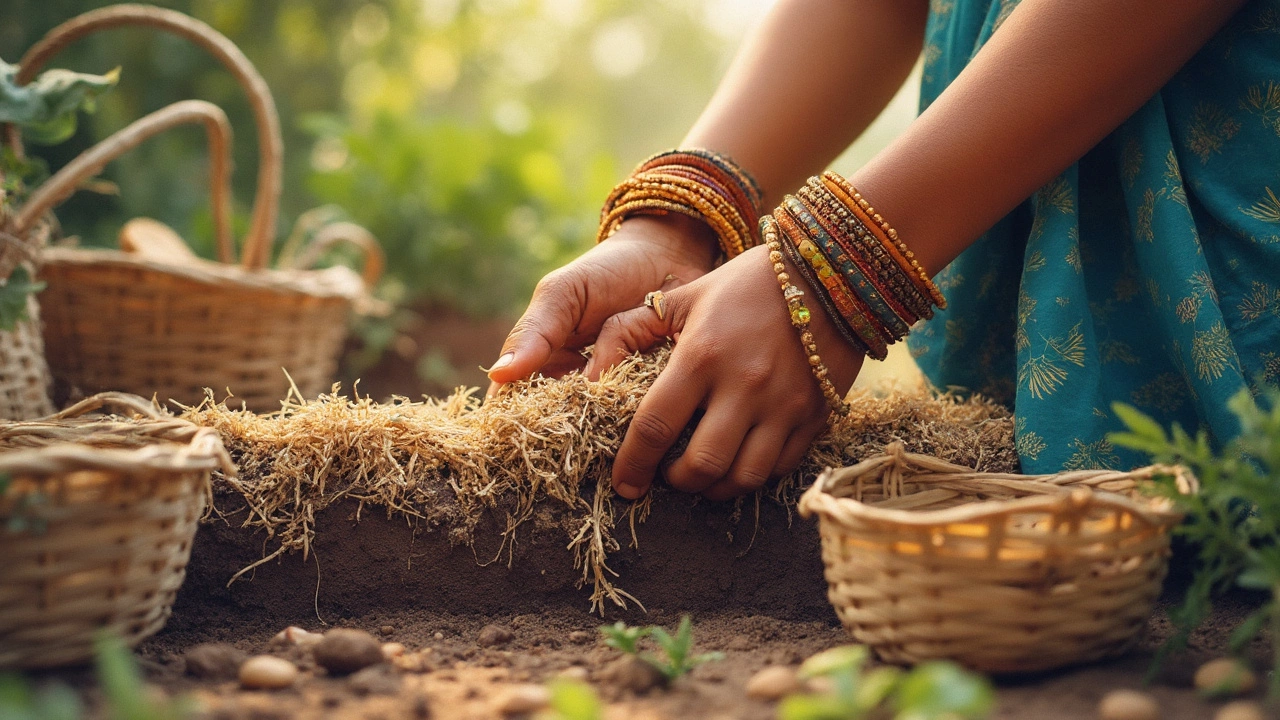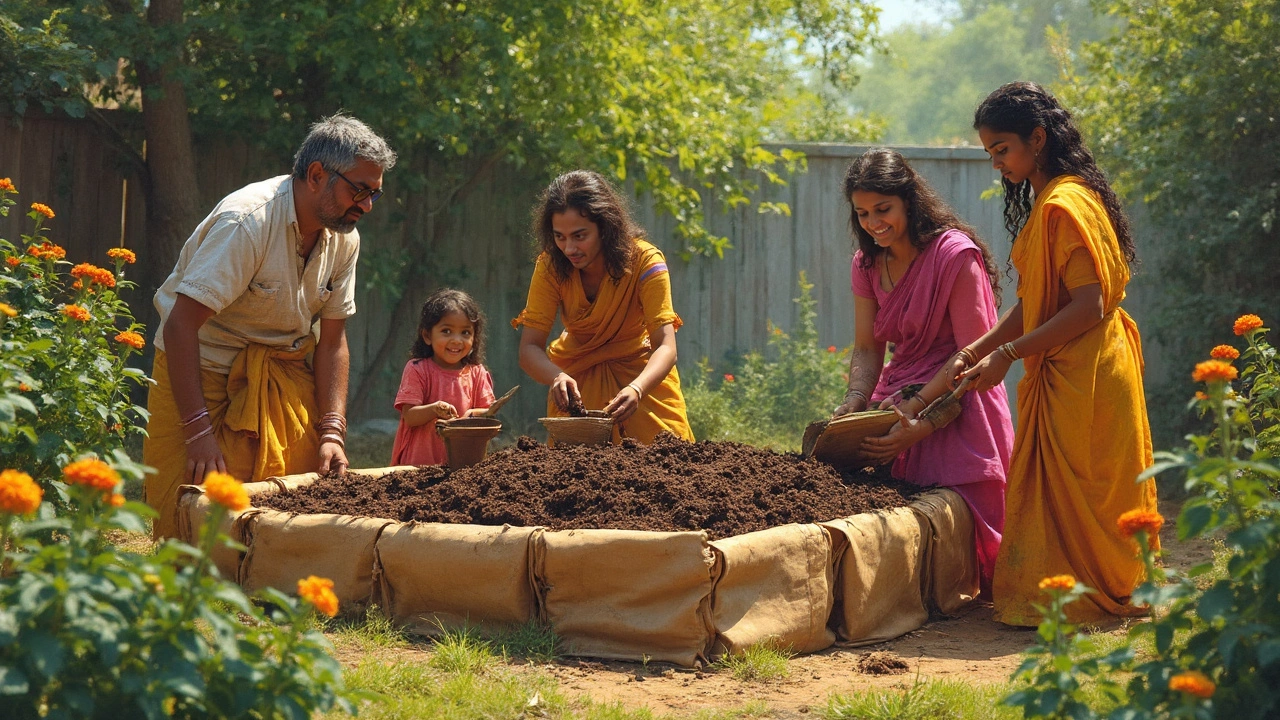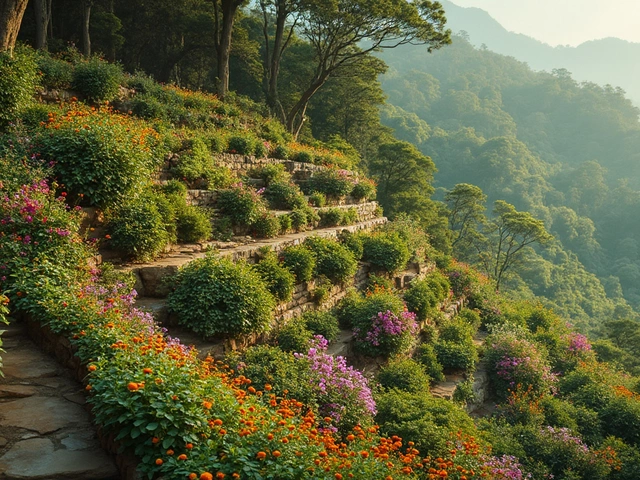Filling a raised garden bed sounds simple, but wow, it eats up way more soil than you’d expect—and good bagged garden soil isn’t cheap. You don’t have to shell out hundreds just to start growing tomatoes. The trick is to fill most of that space with cheaper, sometimes free, materials that hold moisture, break down over time, and give your plants a strong base.
Most folks don’t realize the bottom two-thirds of a deep raised bed can be made of stuff you’d otherwise toss: think sticks, leaves, cut grass, or even partly-rotted logs. This scores you bonus points for recycling and stops you from paying for dirt you don’t need. Plus, as these materials break down, they feed your plants—nature does the heavy lifting.
The top layer is where you want to splurge a bit with some real soil or compost. But the bulk underneath is prime territory for cost-cutting tricks, and it makes your bed lighter and easier to manage over time. Not sure where to start hunting for free mulch or soil boosters? Read on for step-by-step ideas that’ll fill your raised bed and leave enough cash for next season’s seeds.
- Why Raised Beds Need So Much Soil
- Layering for Savings: Hugelkultur, Cardboard, and More
- Where to Score Free or Cheap Organic Matter
- Mixing Your Own Inexpensive Soil Blend
- Mistakes to Dodge and Tips for Healthy Beds
Why Raised Beds Need So Much Soil
Ever noticed how a raised garden bed seems to swallow up way more dirt than you planned? That’s not your imagination. Raised beds are usually deeper than your standard in-ground plot, so they need loads of stuff to fill up all that space. A classic 4x8 foot bed, just 12 inches high, takes about 32 cubic feet—that’s over a dozen hefty bags from the store. If you go taller (say, 24 inches), it nearly doubles. That adds up fast, both in volume and dollars.
So, why all the soil? Plants in raised beds don’t get nutrients or moisture from the ground underneath—they depend completely on what you put in the box. You want at least 8 to 12 inches of good growing mix up top because healthy roots need space to stretch out. Go too shallow, and your veggies get stunted, dry out too fast, or never really take off.
Dr. Linda Chalker-Scott, horticulturist at Washington State University, puts it simply:
“Raised beds give you control over soil quality and drainage, but they do require a bigger up-front investment to fill them right.”
Here’s a look at just how much material you need based on bed size:
| Bed Size (Feet) | Bed Depth (Inches) | Soil Needed (Cubic Feet) | Standard Bag (1.5 cu ft) Needed |
|---|---|---|---|
| 4 x 8 | 12 | 32 | 21 |
| 4 x 8 | 24 | 64 | 43 |
| 4 x 4 | 12 | 16 | 11 |
To put it simply, the bigger your bed and the deeper you make it, the more you’ll have to fill. That’s why people look for cheap (or even free) ways to fill the bulk of that space, reserving quality garden soil for the top. It’s smart gardening and way kinder to your wallet. Plus, getting clever on how you fill those beds can actually boost your plant health and save water, too.
Layering for Savings: Hugelkultur, Cardboard, and More
Cutting costs on your raised garden bed starts with smart layering. This isn't about just dumping random stuff in a box. The right layers save cash, build better soil, and actually make your bed perform better for years.
One method that gets gardeners talking is hugelkultur. It’s a German idea that uses rotting logs and branches as the bottom layer. You fill your bed first with wood (avoid black walnut, cedar, or treated boards—they can harm your plants), then layer smaller sticks, dry leaves, and grass clippings above that. This woody base soaks up water like a sponge and gradually breaks down, feeding your plants all season long. A lot of permaculture folks say that beds set up this way hold water longer and need less fertilizer.
Next up, cardboard. Lay down big, non-glossy pieces of cardboard right on the ground before you start piling stuff in. This simple step blocks weeds, attracts earthworms, and breaks down into rich organic matter. Make sure to peel off any tape or labels first, though—those don’t rot.
Here’s a simple way to layer your cheap soil fill for raised beds:
- First layer: Thick logs or big branches (broken up, not treated or painted)
- Second layer: Smaller sticks, twigs, and chunky yard debris
- Third layer: Leaves, grass clippings, old straw or hay
- Fourth layer: Plain cardboard or even newspaper (wet it down so it stays put)
- Top layer: Compost, topsoil, or store-bought raised bed mix
Skip things like glossy magazines, painted or pressure-treated wood, or yard waste sprayed with chemicals. These can leach nasty stuff into your food crops.
Just to give you an idea of how much you can save, check this out:
| Material | Average Cost (per cu ft) |
|---|---|
| Bought Garden Soil | $8 |
| Yard Waste (free) | $0 |
| Cardboard (scrounged) | $0 |
The more of that free stuff you use for filling raised beds, the more of your budget you keep for the good stuff up top. This isn’t cutting corners—most plants love a mix of decaying organics under their roots. Your garden, and your wallet, both come out ahead.

Where to Score Free or Cheap Organic Matter
Let’s cut to the chase: filling a raised garden bed gets a lot easier once you know where to grab free or dirt-cheap stuff to bulk it up. The more organic matter, the better. It all breaks down, feeds your soil, and keeps costs low. You don’t need to get fancy. Here’s where to look:
- Yard Waste: Leaves, grass clippings, and small sticks are your best friends. Every fall, folks bag up leaves and set them on the curb. Take a drive or walk and you’ll spot plenty. Just ask before grabbing someone’s bags—most people are happy to let you have them.
- Wood Chips and Logs: Tree-trimming companies almost always have too many wood chips. Many will drop a load at your place for free if you just ask. Use larger logs or branches at the very bottom of your bed for a long-lasting core.
- Compost: Some cities actually give away free compost. Check with your local municipality, waste management, or community garden. It may not be perfect, but it sure is better than nothing for filling that lower half fast.
- Straw and Hay: Local farms sometimes have old, moldy hay or straw bales they want gone. This stuff is great for filling beds, and it helps hold in moisture. Just avoid bales sprayed with herbicides.
When gathering garden soil hacks like these, just be picky about what you use. Avoid anything treated with chemicals. If you’re unsure, ask. Here’s some wild info: the EPA says yard trimmings made up more than 35 million tons of municipal solid waste just a few years ago. That’s a massive supply right in your community.
| Material | Where to Find | Cost |
|---|---|---|
| Leaves & Grass | Curbside, Local Parks | Usually free |
| Wood Chips | Tree Services | Often free |
| Compost | City Programs | Free or low-cost |
| Straw/Hay | Farms, Feed Stores | Low-cost or free (if old) |
"Most gardeners underestimate how much free organic material is available in their own neighborhoods. One hour of scavenging can save you hundreds on filling raised garden beds."
— Joe Lamp’l, host of Growing a Greener World
Also, check out local Facebook groups, neighborhood apps, or Freecycle for folks giving away dirt, compost, or mulch. One quick post and you might score enough to beef up every bed you’ve got.
Mixing Your Own Inexpensive Soil Blend
Building a good mix for your raised garden bed is easier than it sounds, and you don’t need to buy those pricey "garden bed mix" bags at the store. The secret? Use bulk materials like local topsoil, compost (homemade or free from your city), and "bulking" stuff like shredded leaves or coconut coir. With the right combo, you’ll get healthy plants without wrecking your wallet.
Here’s a basic recipe that works for most veggies and flowers. You can adjust it based on what you’ve got around, but this is a solid place to start:
- 60% local topsoil (grab from your yard or buy in bulk—it’s way cheaper than bagged soil)
- 30% compost (homemade is free; city compost piles or community gardens often have it too)
- 10% bulky, organic material (think shredded leaves, grass clippings, coconut coir, or peat moss if you already have some lying around, but try not to buy it new)
Mixing thoroughly is key. Toss all the ingredients together in a wheelbarrow or right in the garden bed. Break up any clumps and get things pretty even. This cheap blend holds water but doesn’t turn into a swamp when it rains, and it gives your plants a buffet of nutrients as things break down.
If you want numbers, here’s a rough breakdown of costs for a 4x8 foot bed, 12 inches deep (32 cubic feet):
| Material | Amount | Typical Cost* |
|---|---|---|
| Topsoil | ~19 cu ft | $10-$30 (bulk pickup) |
| Compost | ~10 cu ft | Free-$20 |
| Bulky material | ~3 cu ft | Usually free |
*Costs will be lower if you’re using yard waste or city compost. Bagged soil costs way more—sometimes five times higher.
Don’t have enough compost? Mix in worm castings, mushroom compost, or spent coffee grounds (ask at your local café). Skip construction sand or play sand—they don’t feed plants. After you fill your bed, water everything well and add a top layer of mulch to lock in moisture.





